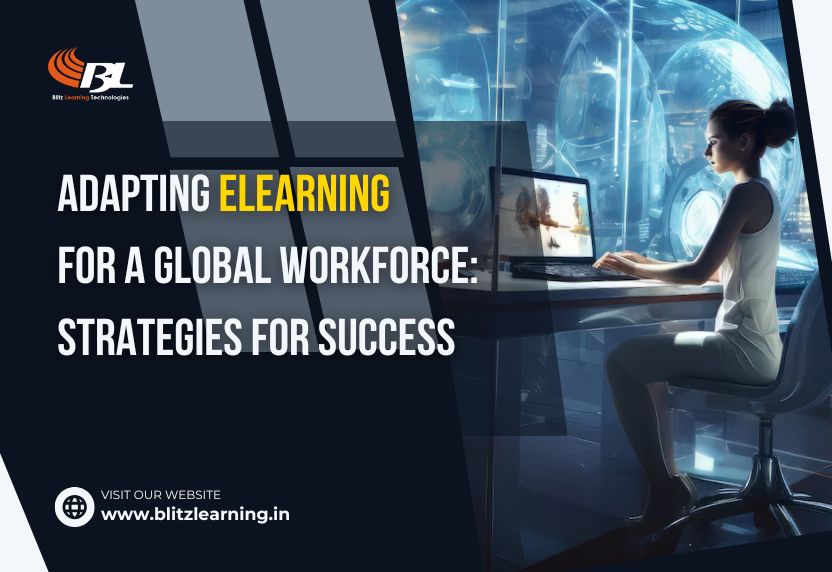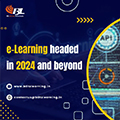
Blog
- Home
- Blog

17Oct
Adapting eLearning for a Global Workforce: Strategies for Success
Introduction
In an increasingly interconnected world, organizations are expanding their reach across borders, bringing together diverse teams from different cultures, languages, and time zones. As businesses globalize, so too must their training and development programs. eLearning has emerged as a powerful tool for delivering education and training to a global workforce, offering flexibility and scalability. However, adapting eLearning to meet the needs of a global audience requires careful consideration of various factors to ensure that it is effective, inclusive, and engaging.
Understanding the Challenges of a Global Workforce
Before diving into the strategies for adapting eLearning, it’s essential to recognize the challenges that come with training a global workforce:
1. Cultural Diversity: Employees from different cultures may have varying learning preferences, communication styles, and attitudes toward training. What works in one region may not be effective or appropriate in another.2. Language Barriers: Language differences can create significant challenges in eLearning. Not all employees may be fluent in the language in which the training is delivered, leading to potential misunderstandings or disengagement.
3. Time Zone Differences: Coordinating live training sessions across multiple time zones can be difficult, making it essential to offer asynchronous learning options that employees can access at their convenience.
4. Technological Disparities: Access to technology and the internet can vary widely across regions. Some employees may have limited access to high-speed internet or the latest devices, affecting their ability to participate fully in eLearning.
5. Legal and Regulatory Considerations: Different countries have different laws and regulations regarding training, data privacy, and certification. eLearning programs must be tailored to comply with these requirements.
Strategies for Adapting eLearning for a Global Audience
To effectively adapt eLearning for a global workforce, organizations must take a strategic and thoughtful approach. Here are some key strategies to consider:
1. Localization and Translation
Language Translation: Ensure that all eLearning materials are translated into the local languages of your workforce. Avoid literal translations and instead use language that is culturally relevant and easy to understand.Cultural Sensitivity: Adapt images, examples, scenarios, and references to align with local cultural norms. What is acceptable in one culture might be inappropriate in another, so it’s crucial to review content through a cultural lens.
Currency and Measurement Units: Adjust any financial data, measurements, or dates to match local formats to avoid confusion.
2. Flexible Learning Options
Before diving into the strategies for adapting eLearning, it’s essential to recognize the challenges that come with training a global workforce:
Asynchronous Learning: Provide eLearning modules that employees can access at any time, allowing them to learn at their own pace and on their own schedule. This is especially important for teams spread across different time zones.
Mobile-Friendly Design: Ensure that eLearning content is mobile-friendly, enabling employees to access training on their smartphones or tablets. This is particularly important in regions where mobile devices are the primary means of internet access.
Microlearning: Break down content into smaller, digestible modules that employees can complete quickly. This approach is effective for busy professionals and allows for greater flexibility in how learning is consumed.
3. Inclusive and Accessible Content
Creating inclusive and accessible eLearning content is crucial to ensuring that all employees, regardless of their location or abilities, can benefit from the training:
Universal Design Principles: Use universal design principles to create content that is accessible to people with disabilities. This includes providing subtitles for videos, ensuring screen reader compatibility, and using high-contrast colors for better visibility.
Avoid Jargon and Idioms: Use clear and simple language that can be easily understood by non-native speakers. Avoid jargon, idioms, and colloquial expressions that may not translate well across languages.
Interactive Elements: Incorporate interactive elements such as quizzes, simulations, and discussion forums to engage learners and cater to different learning styles.
4. Leveraging Technology for Global Training
Technology plays a critical role in delivering eLearning to a global workforce. Leveraging the right tools and platforms can enhance the learning experience:
Learning Management Systems (LMS): Use an LMS that supports multiple languages and allows for customization based on regional needs. The LMS should also provide analytics to track learner progress across different regions.
Virtual Classrooms: For live training sessions, use virtual classroom platforms that offer features like real-time translation, breakout rooms, and collaborative tools to facilitate global participation.
Cloud-Based Solutions: Cloud-based eLearning platforms ensure that content is accessible from anywhere in the world, regardless of the local infrastructure. This also allows for seamless updates and content delivery.
5. Continuous Feedback and Improvement
Adapting eLearning for a global audience is an ongoing process that requires continuous feedback and improvement:
Solicit Feedback: Regularly collect feedback from employees across different regions to understand their challenges, preferences, and suggestions for improvement.
Analyse Data: Use data analytics to identify trends, completion rates, and areas where learners may be struggling. This information can inform future updates and refinements to the eLearning program.
Iterative Improvements: Continuously update and refine eLearning content based on feedback and data analysis to ensure that it remains relevant and effective for all employees.
Conclusion: Unlocking the Potential of a Global Workforce
As organizations continue to expand globally, the ability to deliver effective eLearning that resonates with a diverse workforce becomes increasingly important. By taking a thoughtful and strategic approach to adapting eLearning for a global audience, companies can empower their employees with the knowledge and skills they need to succeed, regardless of where they are located. The key lies in understanding the unique challenges of a global workforce and implementing strategies that make learning accessible, engaging, and inclusive for everyone. With the right approach, eLearning can unlock the full potential of your global workforce, driving innovation, collaboration, and success on a global scale.




Leave a comments